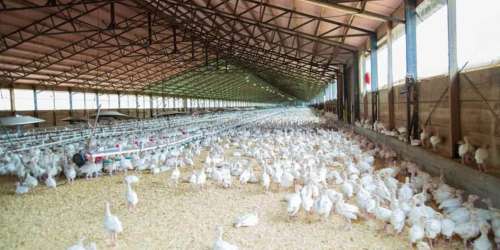Starting a poultry farming business can be a terrific way to make money, but you must have a clear and precise business plan in place before you begin.
This tutorial will take you step by step through the process of developing a poultry business plan, including everything from market research to financial planning. A solid business plan will assist you in making educated decisions, avoiding costly mistakes, and increasing your chances of success.
The poultry business is a chicken farming business. Some aspects must be considered while starting a poultry business, such as feeding, management, diseases, poultry breeding, and so on. These issues must be investigated and treated thoroughly in order for the firm to run smoothly.
The phrase “poultry” refers to a wide variety of birds, including indigenous and commercial chicken varieties, turkeys, guinea fowl, pigeons, ducks, and geese.
Why Write A Business Plan For a Poultry Farm
A farmer should prepare a business plan for their poultry farm for a variety of reasons. To begin, a business plan can assist the farmer in defining their goals and objectives, as well as developing a strategy for accomplishing them.
A business plan can also assist a farmer in obtaining financing from banks or investors. A business plan can also be used to track the farm’s progress over time and make changes as needed.
Finally, a business plan can assist a farmer in communicating his or her vision and intentions to others, such as family members, employees, or other farmers.
What Information is Needed To create a Business Plan For a Poultry Farm?
The farmer will need to gather several crucial pieces of information in order to construct a business plan for a chicken farm. They must first research the poultry market, especially the need for chicken and eggs in their area.
They will also need to research the competition and determine how to differentiate their company. Also, they will also need to develop a financial plan that details their company’s costs and income. They will also need to develop a marketing strategy outlining how they intend to advertise their items and attract clients.
Types of Poultry Business
A farmer could consider several different sorts of poultry enterprises.
A broiler farm, which concentrates on growing birds for meat production, is one alternative. Broiler farms are typically large-scale businesses that raise hundreds of thousands of chickens at a time. These farms often necessitate a huge investment in equipment and infrastructure, as well as a large number of personnel.
An egg farm, which concentrates on raising chickens for egg production, is another possibility. Large-scale or small-scale egg farms are also possible. Small-scale egg farms usually have a few hundred chickens, and large-scale egg farms might have tens of thousands.
Smaller-scale choices include a home poultry farm or a free-range chicken farm. With only a few dozen chickens, backyard poultry farms are often the smallest sort of poultry farm. Similar to backyard poultry farms, free-range poultry farms enable the hens to wander freely outside throughout the day.
A farmer can select the sort of poultry business that best fits their abilities, interests, and resources.
How To Write a Poultry Business Plan in Nigeria
Writing a poultry farm business plan is a laborious task because the success or failure of your business is determined by how well you plan your business. The following are some examples of business plans:
#1. Executive summary
This part should provide a high-level summary of your poultry business and should be kept brief and to the point, as it is intended to provide the reader with a quick glimpse of your operation. This section contains the following items:
- Mission Statement: The mission statement should be a one- or two-sentence summary of your poultry business’s purpose. This should be clear, concise, and simple to comprehend.
- Target Market: Describe your target market in this part, including demographics such as age, gender, geography, and income level. Include details on your target market’s needs and pain spots, as well as their purchasing patterns and decision-making processes.
- Competitive Advantage: This section should explain what distinguishes your poultry business from your competitors.
#2. Company Description
This part should include more specific information about your poultry company, such as its history, organization, and ownership. Include your company’s legal structure (e.g., sole proprietorship, partnership, or LLC), location, and any applicable licenses or permits. Finally, this part should describe your company’s long-term aims and ambitions.
#3. Industrial Analysis
This section should provide an overview of the poultry industry, including market size and growth, industry trends, important players, and the competitive landscape. You should also include information about the primary demand factors, such as population growth, economic conditions, and shifting customer preferences. According to the most recent industry forecasts, the global poultry business will be worth $520 billion by 2030. Furthermore, the African poultry market is expected to increase at a CAGR of 3.9% between 2021 and 2030.
#4. Market Analysis
This market analysis part should include information on the size of the target market, the target customer profile, and any demographic data pertinent to your organization.
For example, you could want to add information on your target clients’ age, gender, income level, and geography. You should include information about how your target clients are currently meeting their market needs, as well as any unmet needs that your company can address.
There are a few subsections in the Market Analysis section that you should look at. First, include a section describing your product’s Unique Selling Proposition (USP). This should specify the qualities or benefits of your product that set it apart from its competitors.
Include a section on your pricing strategy, which should detail how you want to sell your product and how it compares to similar products on the market. Finally, you may wish to include a distribution section that outlines how you intend to distribute your product to your target clients.
#5. Marketing Plan
The Marketing Plan section should outline how you intend to advertise your product to your target clients. This should include details about the methods you’ll utilize to reach out to your target clients, such as social media, email, and traditional marketing channels. You should also give a precise timeline for your marketing initiatives as well as the funding you’ve set up for each.
You can include a full explanation of your product’s market positioning in the Marketing Plan. This section should detail how you want to position your product in terms of pricing, quality, and features, as well as how this positioning matches the needs of your target clients. You can also mention your product’s branding approach, such as the name, logo, and tagline you want to utilize.
#6. Operations Plan
The Operations Plan section should include the procedures you’ll take to manufacture and deliver your product. This should include details about your manufacturing method, as well as any equipment or facilities you’ll require. You should also provide details about your supply chain, such as any vendors or suppliers with whom you will be dealing. Include information about your order fulfilment and customer service processes.
#7. Management Plan
This should include your management plan, leadership style, organizational structure, and decision-making process. Include your method of hiring and training personnel, as well as your plans for performance management.
This section might also incorporate your financial management methods, including budgeting and financial reporting procedures. You might add a section on the risk management plan to your Management Plan.
This section should detail the potential risks that your company confronts, such as market developments, competition, or economic situations. You should also detail your risk management and mitigation initiatives. You can also include a section on contingency planning, explaining how you’ll deal with unanticipated circumstances.
#8. Financial Plan
Your financial predictions, including revenue, expenses, and cash flow, should be included in the Financial Plan section. A break-even analysis, which shows how much you need to sell to pay your costs, should also be included.
You can also include details about your financial strategy, such as any loans or investments you intend to seek, as well as your budget and financial reporting.
You might add a sensitivity analysis in this part to indicate how your estimates may alter if specific variables, such as sales volume, price, or costs, change. This can assist you in identifying the major aspects that can affect the financial performance of your company. You can also include a statement of assumptions, which highlights the important assumptions you’re making about your company’s future.
#9. Appendix
You can put any supporting information relevant to your business strategy in the Appendix section. Market research, product specs, and any other data that supports your assumptions or estimates might be included.
You can include legal documents for your company, such as articles of incorporation or a business license. Resumes of your management team members, your company plan, and any other supporting material, such as contracts or insurance policies, can also be included.
Requirements Needed To Start A Poultry Business
A farmer must meet various legal and regulatory standards before starting a chicken farm. A farmer will almost always need to obtain a license or permit from their local authorities.
They must also follow any zoning or environmental restrictions that apply in their location. To secure their business, farmers must purchase insurance.
They will require finance, whether from a bank or another source, to cover the costs of launching and running their business.
A building that meets the demands of the hens is one of the most critical prerequisites for starting a poultry farm. A house or coop that provides shelter and protection from the elements, as well as space for the chickens to roam and graze, is included. Furthermore, the facility will require proper ventilation, lighting, and temperature control.
A source of feed, such as commercial feed or locally farmed grains, as well as a source of water, will also be required by the farmer. Finally, the facility must be designed to collect and dispose of manure in an environmentally responsible manner.
What is the Financial Forecast For a Poultry Farm
A financial forecast is an estimate of a company’s future financial performance. The financial forecast for a chicken farm would include predictions of income and expenses such as feed, housing, and labour. The projection would also contain sales and income predictions based on predicted demand for chicken products. The farmer can use this information to make decisions about the size and breadth of their enterprise, as well as the pricing of their products.
Advantages of Poultry Farming
There are numerous benefits to launching a chicken farming business. They include:
- It is a low-cost business to establish. Poultry is also a rapidly growing business, so there is plenty of room for expansion.
- Poultry farming is a relatively straightforward company to operate, requiring no training or experience.
- Because there is a growing need for chicken goods, new enterprises have a significant chance of success.
- Poultry farming may be an environmentally benign and sustainable company. Poultry can be raised on a small scale, reducing the environmental impact of farming.
- Poultry can be raised organically and humanely, appealing to people interested in ethical and sustainable food options.
- Poultry farming may generate revenue for farmers and rural communities.
How Much Do I Need to Start a Poultry Business?
In Nigeria, the average cost of establishing a chicken farm is around N150,000. This price includes the purchase of day-old young chickens, as well as the necessary equipment and materials. In Nigeria, the cost of establishing a commercial chicken farm might reach N1 million.
How Do I Advertise My Poultry Business?
Before you begin production, be sure you’ve identified your market and potential clients and buyers. You can go to schools, restaurants, and hotels, among other places. Present your proposal to them and explain why they should purchase from you.
What is the Cost of Rearing 100 Broilers in Nigeria?
The bulk are capital costs, which means they will not be incurred in future manufacturing. To rear 100 broiler chicks for 8 weeks, you’ll need at least 418,060. You don’t need all of this money at once to start a broiler farm; in fact, you might just need a quarter to get started.
How do I write a business Plan on Poultry Farming?
Your poultry farming business plan should explain simply how you intend to sell your products or services. Your sales plan must be targeted. Determine how many sales representatives you will need to hire and how you will find and hire them. Remember to add your sales goals as well.
What is the Business Description of Poultry Farming?
Poultry farming is the household or commercial production of birds for meat and eggs, but also for feathers. Chickens, turkeys, ducks, and geese are the most important, whereas guinea fowl and squabs (young pigeons) are only of local value.
Conclusion
To summarize, beginning a poultry farm is a complicated and multifaceted procedure. It necessitates meticulous preparation, research, and attention to detail. However, it may also be a rewarding and profitable venture, particularly for farmers who are enthusiastic about raising poultry and providing high-quality goods. A chicken farm may be a profitable business that delivers a regular income for years to come with proper planning and execution.
- POULTRY FARMING BUSINESS: Baby-steps to Setup a Cost-effective Business in Nigeria
- POULTRY BUSINESS: Beginners’ Guide to Launch a Lucrative Poultry Business
- 2023 Agriculture Loan List, Updated!!!(13 + Application guide)
- Most Lucrative Business In The World 2023 (Updated!!)
- BUSINESS FARMING: Profitable Ideas on How to Start a Small Farm Business






